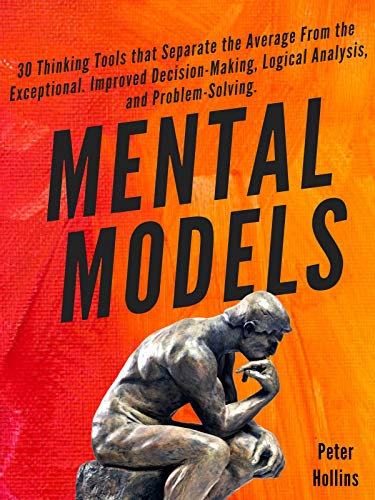This post is part of the 📖 Mental Models series.
Today, I am reading the seventh mental model Ignore “Black Swans” from How to See More Clearly chapter of the book Mental Models written by Author Peter Hollins.
Mental Models are like giving a treasure map to someone lost in the woods. They provide instant understanding, context, and most importantly, a path to the end destination. Now imagine having such a map for all problems and decisions in your life.
In this book Mental Models, author Peter Hollins discuss 30 mental models that billionaires/CEOs, Olympic athletes, and scientists use to think differently and avoid mistakes.
Battle information overwhelm, focus on what really matters, and make complex decisions with speed and confidence.
Yesterday, I finished reading the sixth mental model Minimize Regret.
Chapter #2: How to See More Clearly
Sometimes we don’t get complete information—there’s always something we can’t see or hear that might be driving events.
These mental models discussed in this chapter helps us see through the distractions and false realities of everyday existence so you can get as close to the core truth as you possibly can.
Mental Model #7:
Ignore “Black Swans”
Use to understand how outliers shouldn’t actually change your thinking.
Until nearly the 18th century, people in the Western world believed that all swans were white. Their reasoning was simple: they’d never seen anything besides white swans.
But in 1697, Dutch explorer Willem de Vlamingh and his crew saw what no European had ever seen before: black swans — lots of them.
Goodbye centuries of supposed knowledge, hello indisputable evidence of being incorrect.
Statistician Nassim Nicholas Taleb uses the black swan as a metaphor to describe unpredictable events that create a massive change in perception, perspective, and understanding.
And yet, a black swan event is something an anomalous outlier, that you should not change your perception or accepted knowledge.
A black swan event may simply create awareness of possibilities, but most black swan events don’t deserve to be accounted for in everyday life.
On a global scale, events like the fall of the Berlin Wall, the assassination of a public figure, and the tragedy of 9⁄11 could be considered black swan events.
On a more personal level, they could include a factory suddenly closing, a local company being bought out by a major conglomerate, parents divorcing, a house being burgled — anything that disrupts and upends our placement or personal views.
This mental model is about looking past the gravity of a black swan event, zooming out, and seeing the whole picture. Don’t organize your entire strategy around the likelihood of a black swan event.
Key Takeaways
- Humans don’t naturally think or see objectively.
Summary
Ignore “Black Swans.” This is the first mental model that warns explicitly against our tendency to jump to conclusions based on imperfect, skewed, or incomplete information.
A black swan event is an entirely unpredictable event that comes out of nowhere. Doing so skews all data and beliefs, and people start to take the black swan into account as a new normal. But these are just outliers that should be ignored.
That’s it for today. Tomorrow, we will read the eigth mental model Look for Equilibrium Points, use to find real patterns in data and not be fooled.
Address “Important”; Ignore “Urgent”
Identify and address important tasks, ignore urgent tasks. Delegate important but non-urgent task and delete not important and not urgent tasks.
Visualize All the Dominoes
Don’t stop your analysis once the most obvious situations are articulated. Consider as many long-term possible ramifications as you can. Think twice about what you’re doing, and it helps to eliminate rash decisions.
Make Reversible Decisions
If you want to make the best decision possible, you can go ahead and use reversible decisions to learn exactly what you need to know.
Seek “Satisfaction
We need far fewer things than we originally thought and that our desires are masquerading as needs. Use Seek “Satisfaction” to achieve your priorities and ignore what doesn’t matter by creating a default choice.
Stay Within 40-70%
Utilize this mental model by intentionally consuming less information and even overgeneralizing — this means not looking at the subtleties of your options.
Minimize Regret
Minimize Regret. Jeff Bezos developed what he calls the regret minimization framework. In it, he asks one to visualize themselves at age 80 and ask if they would regret making (or not making) a decision. This simplifies decisions by making them about one metric: regret.
Ignore “Black Swans”
A black swan event is an entirely unpredictable event that comes out of nowhere. Doing so skews all data and beliefs, and people start to take the black swan into account as a new normal. But these are just outliers that should be ignored.
Author(s): Peter Hollins
Part 8 of 29 in the 📖 Mental Models book series.
Series Start | Mental Models - Day 7 | Mental Models - Day 9
